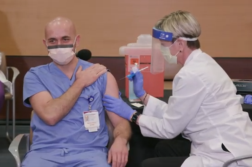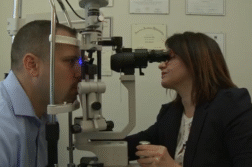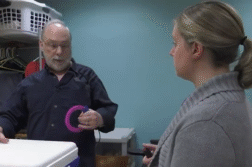CINCINNATI, Ohio (Ivanhoe Newswire) – More than 1.7 million Americans are treated for traumatic brain injuries each year. The main causes – stroke, car accidents, bad falls and assault. But did you know a hard hit to your head can also trigger a brain tsunami? There’s no treatment for it, and it can kill off brain cells one by one in a matter of days. Now, for the first time, researchers have found a way to stop it and possibly save more brain tissue from dying.
A tsunami — a massive wave of destruction — but it doesn’t just happen on the coast – it can happen inside your brain. These brain tsunamis – or spreading depolarizations – happen in people who have suffered a traumatic brain injury, or TBI.
“We’re finding out is a likely culprit in more and more diseases than we ever thought imaginable. It’s kind of like the hidden iceberg below the surface,” explains neuroscientist at University of Cincinnati College of Medicine, Jed Hartings, PhD.
After a TBI, brain cells can begin to short circuit and die. For the first time ever, researchers at the University of Cincinnati have found a way to diagnose and test tsunamis to prevent more.
Laura Ngwenya, MD, PhD, neurosurgeon at University of Cincinnati College of Medicine, UC Health says, “This has actually been revolutionary, in terms of how we think about how we treat brain injury patients.”
Dr. Ngwenya is using the same technology they currently use to monitor TBI patients, but with a new algorithm.
“We place an electrode strip on the surface of the brain, and this allows us to detect seizure activity, but it also allows us to detect these abnormal brain tsunamis,” Dr. Ngwenya explains.
Researchers found the drug ketamine can stop the wave. Also, doctors can monitor blood pressure and body temperature to prevent spreading depolarizations. Brain tsunamis, or spreading depolarizations, can happen continuously for up to a couple of days in traumatic brain injury patients or continue on and off up to two weeks after a severe injury. There is currently no standard of care for spreading depolarizations but doctors hope after a larger clinical trial, they will be able to create one.
Contributors to this news report include: Marsha Lewis, Producer; Matt Goldschmidt, Videographer; Roque Correa, Editor.
To receive a free weekly e-mail on medical breakthroughs from Ivanhoe, sign up at: http://www.ivanhoe.com/ftk
Source:
https://www.ncbi.nlm.nih.gov/books/NBK459300/
MEDICAL BREAKTHROUGHS
RESEARCH SUMMARY
TITLE: BLOCKING BRAIN TSUNAMI
REPORT: MB #5377
BACKGROUND: Spreading depolarization, also known as “brain tsunamis,” is a process that causes electrochemical membrane failure and neuronal swelling in the gray matter of the brain. It is not only associated with ischemic tissue but can also be triggered by various harmful factors such as electrical, chemical, thermal, or mechanical disturbances. Spreading depolarization is linked to several diseases and conditions, including migraine-associated aura, traumatic brain injury (TBI), subarachnoid hemorrhage, intracerebral hemorrhage, ischemic stroke, brain death prior to circulatory collapse, and sudden unexplained death in epilepsy. When spreading depolarization invades tissue that has not already been electrically silenced by the triggering pathology, it causes a loss of spontaneous and evoked activity.
(Source: https://www.ncbi.nlm.nih.gov/pmc/articles/PMC9259543/)
DIAGNOSING: Traumatic brain injury usually results from a violent blow or jolt to the head or body. An object that goes through brain tissue, such as a bullet or shattered piece of skull, also can cause traumatic brain injury. Mild traumatic brain injury may affect your brain cells temporarily. More-serious traumatic brain injury can result in bruising, torn tissues, bleeding and other physical damage to the brain. Some signs or symptoms may appear immediately after the traumatic event, while others may appear days or weeks later. However, a hard hit to the head can also trigger a brain tsunami.
(Source: https://www.mayoclinic.org/diseases-conditions/traumatic-brain-injury/symptoms-causes/syc-20378557 , https://hsc.unm.edu/news/2022/01/researchers-study-ketamine-block-wave-neural-injury.html)
NEW TREATMENT: There is currently no standard of care or treatment for SDs but the University of Cincinnati is leading a first trial testing treatment for spreading depolarizations. Due to the need for surgery to place the electrode strip for monitoring, the trial is focused on patients with TBIs requiring surgery. Laura Ngwenya, MD, PhD, neurosurgical director of the study, said it is standard practice to place these electrode strips to monitor for seizures, but they will now be additionally used to look for SDs. The trial will test three different tiers of treatment. Certain ranges of blood pressure, blood sugar and body temperature measurements are associated with a higher likelihood of having SDs, Ngwenya said. “This is the first step for us to say, ‘Can we treat SDs when we see them?’ Because eventually we want to know if we treat them will we have better outcomes for patients.”
FOR MORE INFORMATION ON THIS REPORT, PLEASE CONTACT:
Tim Tedeschi
If this story or any other Ivanhoe story has impacted your life or prompted you or someone you know to seek or change treatments, please let us know by contacting Marjorie Bekaert Thomas at mthomas@ivanhoe.com




